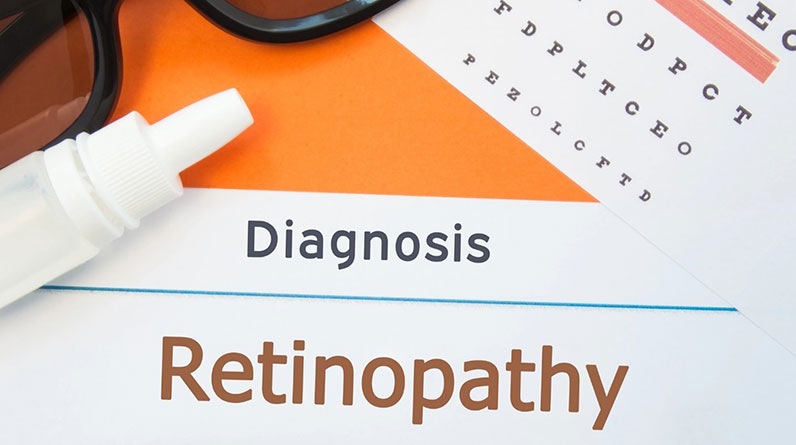
Common Eye Conditions Associated with Diabetes
Diabetes can have a profound impact on eye health, leading to several serious eye conditions that can result in vision loss if not properly managed. Here are some of the most common eye conditions associated with diabetes:
1. Diabetic Retinopathy
Diabetic retinopathy is the most common eye disease among people with diabetes and occurs when high blood sugar levels damage the blood vessels in the retina. In its early stages, it may cause no symptoms, but as it progresses, it can lead to blurry vision, floaters, and even blindness if untreated. Diabetic retinopathy is classified into two types: non-proliferative, where blood vessels weaken and leak, and proliferative, where abnormal new blood vessels grow, increasing the risk of severe vision impairment.
2. Diabetic Macular Edema (DME)
Diabetic macular edema is a complication of diabetic retinopathy that occurs when fluid leaks into the macula, the central part of the retina responsible for detailed vision. This swelling of the macula leads to blurred or distorted central vision and can make tasks like reading or driving difficult. DME is one of the leading causes of vision loss in people with diabetes.
3. Cataracts
People with diabetes are more likely to develop cataracts at an earlier age than those without the condition. Cataracts cause the normally clear lens of the eye to become cloudy, leading to blurred vision and difficulty seeing in bright light. Diabetes accelerates the breakdown of proteins in the lens, increasing the risk of cataract formation and progression. Surgery is often needed to restore clear vision.
4. Glaucoma
Individuals with diabetes are at an increased risk of developing glaucoma, a condition characterized by damage to the optic nerve due to elevated intraocular pressure. The most common form, open-angle glaucoma, may have no early symptoms but can lead to gradual vision loss. Over time, untreated glaucoma can cause significant vision impairment, particularly affecting peripheral vision. Regular eye exams are the key to detecting and managing glaucoma in people with diabetes.
Treatment and Prevention
Managing the impact of diabetes on eye health requires a combination of proactive prevention strategies and effective treatments to minimize the risk of vision loss. The following approaches are essential in both preventing and treating diabetes-related eye conditions.
1. Regular Eye Examinations
Routine eye exams are important for early detection of diabetes-related eye conditions like diabetic retinopathy, macular edema, cataracts, and glaucoma. A comprehensive dilated eye exam allows an eye care professional to thoroughly examine the retina and optic nerve for signs of damage.
For individuals with diabetes, annual eye exams are recommended, or more frequent visits if any signs of eye disease are detected. Early diagnosis through regular exams can prevent or slow down the progression of these conditions before significant vision loss occurs.
2. Blood Sugar Control
Maintaining optimal blood sugar levels is one of the most important steps in preventing diabetes-related eye conditions. Poor blood sugar control damages the blood vessels in the eyes, leading to conditions like diabetic retinopathy and macular edema.
Keeping blood glucose levels within a healthy range helps protect the delicate blood vessels in the retina, reducing the likelihood of developing these complications. In addition, managing blood pressure and cholesterol levels can further reduce the risk of eye diseases and improve overall eye health.
3. Medical Treatments
For individuals diagnosed with diabetes-related eye conditions, there are several medical treatments available depending on the severity of the condition:
- Laser Therapy (Photocoagulation): Used primarily to treat diabetic retinopathy, laser therapy can help shrink abnormal blood vessels in the retina and prevent further leakage.
- Anti-VEGF Injections: For diabetic macular edema, medications such as anti-vascular endothelial growth factor (VEGF) injections can reduce swelling by blocking abnormal blood vessel growth and leakage. These injections help stabilize or improve vision.
- Vitrectomy: In advanced cases of diabetic retinopathy, a surgical procedure called vitrectomy may be necessary to remove blood or scar tissue from the vitreous and retina to restore vision.
- Glaucoma Management: In people with diabetes and glaucoma, treatments may include eye drops, laser therapy, or surgery to reduce intraocular pressure and prevent further damage to the optic nerve.
4. Importance of Monitoring
Closely monitoring both eye health and diabetes is essential to managing the risk of complications. Regular visits to an endocrinologist and an eye care professional help ensure that any changes in vision or eye health are addressed promptly.
Individuals with diabetes should also be vigilant about any sudden changes in vision, such as blurriness, floaters, or dark spots, and seek immediate medical attention if such symptoms occur.
Managing diabetes is not just about controlling blood sugar; it’s also about safeguarding your overall health, including your vision.
The connection between diabetes and eye health is significant, but with proactive measures, it is possible to reduce the risk of serious eye conditions like diabetic retinopathy, macular edema, cataracts, and glaucoma. Taking these steps not only preserves vision but also enhances your quality of life.
By staying vigilant and working closely with your healthcare providers, you can prevent or manage eye-related complications from diabetes. Early detection and prompt treatment are key to maintaining clear vision and preventing irreversible damage.
